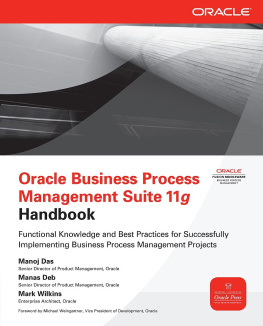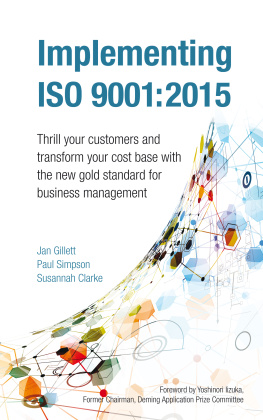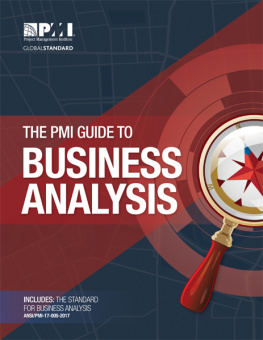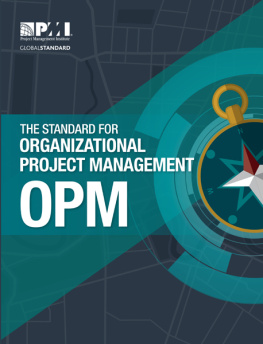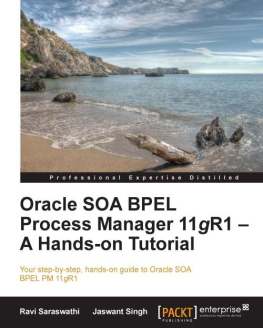PAULA K. BERMAN has acquired her knowledge of process systems and process improvement from her experience at companies ranging from under a hundred to over a hundred-thousand employees in several different industries. She holds a Bachelor's degree in Mechanical Engineering and a Master's degree in Physical Sciences, and qualified as a Six Sigma Black Belt while working at Honeywell Aerospace. While working for ASML, a leader in semiconductor capital equipment, Paula had the opportunity to live and work in Europe and Asia, adding to the breadth of her background. Her varied experience has helped her develop a holistic approach to business process implementation and practical solutions for getting results.
Outside work, Paula reads whenever possible, including during her other hobbies of knitting and traveling. Occasionally she puts the book down to go rowing. She lives in Hillsboro, Oregon, with her husband and two cats.
AFTERWORD
WHEN IT COMES TO process improvements, there's never only one right way to do itjust some basic principles. For any process improvement initiative, there may be a hundred ways to do it right and a thousand ways to do it wrong. What I've tried to do in this book is explain those principles and show the basic tasks and flow in setting up a process system and realizing your procedures. I've also provided specific examples of ways to manage your processes that have worked well in practice. Armed with these, you're ready to make an informed decision about what will work for your business, given your environment's specific constraints and culture.
REMEMBERING THE UNDERLYING PRINCIPLES
In the Introduction to this book, I stated three basic principles:
- Processes work best when they are part of a managed and coherent system.
- To make a documented process useful, you need to launch it successfully and then monitor, measure, and improve it on an ongoing basis.
- There is no one right way to build a process or process system. To have one that works for your business, you need to customize it.
I'm adding one more principle to that list: No process is important in itselfit's what it does for your business that matters. It's easy to get wrapped up in process improvement for its own sake. Avoid this by keeping your business goals and customer needs in view, and design your procedures to satisfy those.
UNDERSTANDING THAT NO PROCESS IS AN ISLAND
Here's a quick way to avoid success in business: Set up every department as an independently functioning entity, and discourage communication among departments. The process structure can be seen as the network uniting all parts of your business. It defines how each procedure is connected to the next in line, ensuring that there are no gaps so that each one gets the inputs it needs and in turn produces the outputs required.
The other part of the process system is the process environment, which defines a standard way to create and maintain your procedures, to deliver them to their users, and to manage their operation. This ensures that process creators work efficiently and don't forget important steps (like consulting process users!). When procedures use a standard format and are stored in a single repository, users know where to find the procedures they need and where to find the information they want inside procedures.
Strive to keep both the structure and the environment as simple and intuitive as they can be. Remember that your customer for both is not the quality department but the process stakeholders: process owners, procedure users, managers who need to monitor these procedures to see how well their business operates, and the customers for process outputs (including, ultimately, your end customers). If the process system isn't working well for them, then it's not good enough. When creating or revising a process system, remember your stakeholders. Whenever there's a question about how to design any aspect of a process system or procedure, try to choose the option that's best for their needs.
MAKING YOUR PROCEDURES MORE THAN PAPER
Creating a good procedure requires considering multiple needs, and then revising through several iterations until everyone is in agreement. Start by defining the scope and goals of your procedure, then work from the outside in. Determine the inputs and outputs first, with the suppliers/customers for each one, and then map the tasks within the procedure. Finally, create a complete document with detailed information to support the process map. Consult your stakeholders at each stage, and revise to incorporate their feedback.
That's not enough, though, to ensure a successful working procedure. Don't wait until you're done documenting to begin planning the implementation of your procedure. Once you have enough basic information and have a good handle on who will be involved in the procedure, what they need to know, and what infrastructure is required to support them, begin creating your rollout plan and your control and monitoring plan.
Remember that you'll need to go through all of this again the next time you create or improve a procedure. Once you've executed your plans and your procedure is running, call the team back together and figure out what lessons you can learn. What went well? What didn't go so well? How can you do better next time? Write these lessons down and (this is the hard part!) consult them before you go to work on your next process improvement initiative. Share them so others can learn from you, and ask other teams to share their own lessons with you.
FACILITATING CONVERSATIONS, DRIVING CHANGE, AND MANAGING YOUR PROJECTS
of this book discusses skills you need to succeed in making improvements and in making them stick. None of these are particularly easy, but experience helps. Practice. Experiment. See what works for you. There are books, classes, and websites devoted to each of these topics. Each topic is complex, and I've only scratched the surface here and provided a few takeaway points:
- Whenever you're having a meeting or workshop in which you need to gather input from all participants, an independent facilitator can be invaluable. A facilitator's job is to keep the conversation on target, make sure everyone is heard, and guide the participants to alignment.
- If you're trying to drive change in an organization, consider two channels: top-down through the management hierarchy, and bottom-up through getting buy-in at the grassroots level. Tailor your message to your audience's concerns, and try to adapt the environment to make the new way of working easy and intuitive.
- Most process improvement initiatives are run as projects. If you take time up front to organize your team and develop a detailed project plan, you greatly increase your chances of finishing successfullyon time and on budget with targets achieved.

Within this book is a lot of information on how to follow these principles to build a useful process system, and to work within it to create, launch, and operate standard procedures. I've included examples and recommendations based on what has worked for me and others, and I hope you will find them helpful. Bear in mind, though, that outside the covers of this book you can find much more information and many more discussions on process systems and how to implement processes. New ideas, tools, and methodologies are released every year, each claiming to help you build procedures to make your business better. Now you have the ability to choose, design, or adapt your own methods, decide on tooling, and create a system of procedures that will help your company do business effectively and improve continually. Success!?




